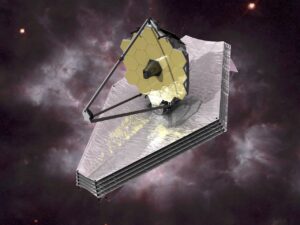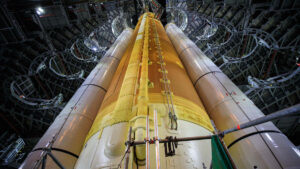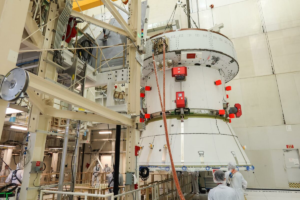
SpaceX’s Falcon Heavy Is Heading To An Asteroid
In less than 24 hours from now, tomorrow morning, a joint mission between SpaceX and NASA will take place. The special payload named Psyche, will utilize the power of the Falcon Heavy to travel around 2.2 billion miles to a metal-rich asteroid. Here, orbiting the sun between Jupiter and Mars, it will study the exposed nickel-iron core of an early planet, one of the building blocks of our solar system.
However, before it can begin its long journey, the Falcon Heavy using reusable boosters and even the fairings, needs to place it on the correct trajectory. The spacecraft is quite big weighing 6,056 pounds (2,747 kilograms) at liftoff. What’s even more demanding is its initial placement into a heliocentric orbit, one around the sun.
By now, teams at SpaceX are completing some of the final preparations for launch. Assuming this launch goes well, it will only add to the busiest year yet for Falcon Heavy. Here I will go more in-depth into tomorrow’s launch, the significance of this mission, the reused hardware, and more.
Final Launch Prep

As of right now, everything looks to be coming together for a launch on time tomorrow morning. Earlier today SpaceX tweeted saying, “Falcon Heavy went vertical overnight on Launch Complex 39 in Florida ahead of its launch of the Psyche mission to an interplanetary transfer orbit. This included an image of the Falcon Heavy on the pad at night. Zooming in you can see the obvious reuse of both the side boosters, still charred from their last launch and return to Earth.
Less obvious is the reuse of the fairing which is a lot less common. One close-up image from NASA however shows a few signs that this is not the first time this fairing will have gone to space. What’s arguably most impressive about this is the high stakes of the mission. NASA must have very high confidence in SpaceX to allow the company to use reused boosters and even fairings to carry and protect a spacecraft worth over $1 billion.
Focusing on the launch itself, SpaceX and NASA are officially targeting Thursday, October 12 at 10:16 a.m. ET for Falcon Heavy’s launch of the Psyche mission to an interplanetary transfer orbit from Launch Complex 39A (LC-39A) at NASA’s Kennedy Space Center in Florida. Also, if needed, a backup launch opportunity is available on Friday, October 13 at 10:19 a.m. ET.
The launch was previously scheduled to happen on October 5th, about a week ago, but was delayed to give engineers more time to verify parameters used for nitrogen cold-gas thrusters that orient the spacecraft. “Operating the thrusters within temperature limits is essential to ensure the long-term health of the units,” NASA said in a statement about the delay, adding that the verification work involves running simulations and making adjustments to flight parameters and procedures. “It’s so important that we get this right,” said the director of the Jet Propulsion Laboratory, which is leading the mission.
Since then these checks have been completed with flying colors and now SpaceX is preparing to run through the launch timeline. Recently, as Falcon Heavy has been launching much more frequently, we have seen quite a few mission profiles which include full reuse, expendable boosters, and more. This all depends on the weight of the payload and its destination. When in an expendable format, Falcon Heavy, and even the Falcon 9, have more propellant to travel as far as possible, rather than keep some in reserve for a landing.
SpaceX clarified that this will be the fourth launch for the side boosters, both of which previously supported USSF-44, USSF-67, and Hughes JUPTER 3. They also were quoted saying, “Following stage separation, Falcon Heavy’s two side boosters will land on SpaceX’s Landing Zones 1 and 2 (LZ-1 and LZ-2) at Cape Canaveral Space Force Station in Florida. They didn’t however, mention the reuse of the center core with a downrage landing. This means we could see an expendable center core to help place this payload in its demanding orbit.
As far as payload deployment, looking at the flight profile shows the payload will finally deploy around an hour after launch. Before then the second stage has two separate burns, one 4 minutes into the launch and another 54 minutes into the launch. A heliocentric orbit (the orbit Psyche is heading to) is an orbit around the barycenter of the Solar System, which is usually located within or very near the surface of the Sun. All planets, comets, and asteroids in the Solar System, and the Sun itself are in such orbits, as are many artificial probes and pieces of debris. The perfect place for a spacecraft heading to an asteroid.
Asteroid Bound

The stakes of this mission are quite high as with any Falcon Heavy launch. Rather than Starlink satellites or a rideshare mission, this launch is carrying a spacecraft that has been under development for over 8 years with immense amounts of money put into it. It also has the opportunity to provide invaluable information assuming it reaches its destination in good shape.
NASA said that “The Psyche spacecraft’s voyage to its namesake asteroid could (almost) be considered a journey to the center of the Earth. Asteroid Psyche might be an exposed core of a planetesimal, an early planetary building block. It might have been stripped of its outer layers by violent collisions during our solar system’s early formation. If it is a planetesimal, asteroid Psyche may offer a close look at the interior of terrestrial planets like Earth. We can’t bore a path to Earth’s metal core – or the cores of the other rocky planets – so visiting Psyche could provide a one-of-a-kind window into the violent history of collisions and accumulation of matter that created planets like our own.
If all goes as planned, asteroid Psyche’s gravity will capture the spacecraft in late July 2029, and Psyche will begin its prime mission in August. It will spend about two years orbiting the asteroid to take pictures, map the surface, and collect data to determine Psyche’s composition. The body of the Psyche spacecraft is about the size of a small van, and it’s powered by solar electric propulsion. It has a magnetometer, a gamma-ray and neutron spectrometer, and a multispectral imager to study asteroid Psyche. The spacecraft will start sending images to Earth as soon as it spots the asteroid.
Scientists think asteroid Psyche, which is about 173 miles (280 kilometers) at its widest point, could be part or all of the iron-rich core of a planetesimal, a building block of a rocky planet. The asteroid could also be something else. It could be the leftover piece of a completely different kind of iron-rich body that formed from metal-rich material somewhere in the solar system. Psyche may be able to show us how Earth’s core and the cores of the other terrestrial planets came to be.
Powered by Hall-effect thrusters, Psyche’s solar electric propulsion system harnesses energy from large solar arrays to create electric and magnetic fields. These, in turn, accelerate and expel charged atoms, or ions, of a propellant called xenon (a neutral gas used in car headlights and plasma TVs) at such high speed, it creates thrust. The ionized gas, will emit a sci-fi-like blue glow as it trails behind Psyche in space. Each of Psyche’s four thrusters, which will operate one at a time, exert the same amount of force that you would feel holding three-quarters in the palm of your hand. In the frictionless void of space, the spacecraft will slowly and continuously accelerate.
Interestingly, Rocket Lab is actually the company that provided these valuable solar cells to help power the spacecraft’s thrusters. To add to everything, a technology demonstration called Deep Space Optical Communications (DSOC) will also fly on Psyche in order to test high-data-rate laser communications that could be used by future NASA missions.
The agency points out that “Tried-and-tested deep space radio frequency communications systems are approaching their bandwidth limit. Yet future space missions are expected to transmit huge volumes of science data, including high-definition images and video, that will require significantly more bandwidth. In other words, an upgrade is required. Much like fiber optics replacing old telephone lines on Earth as demand for data grows, going from radio communications to laser, or optical, communications will allow increased data rates throughout the solar system with 10 to 100 times the capacity of state-of-the-art radio systems currently used by spacecraft.
NASA’s Deep Space Optical Communications (DSOC) experiment is the agency’s first demonstration of optical communications beyond the Moon. DSOC is a system that consists of a flight laser transceiver, a ground laser transmitter, and a ground laser receiver. New advanced technologies have been implemented in each of these elements. The transceiver will “piggyback” on NASA’s Psyche spacecraft when it launches tomorrow to the metal-rich asteroid. The DSOC technology demonstration will begin shortly after launch and continue in two phases for about 2 years. The first phase of operations will last until June 2024 while the second phase is planned from January to October 2025. Another important mission aspect that NASA officials are looking forward to.
Conclusion
SpaceX is just about ready to launch another Falcon Heavy, this time carrying a spacecraft headed to an asteroid. If successful, a few years from now the spacecraft will reach its destination and provide us with invaluable information. We will have to wait and see how it progresses and the impact it has on the space industry.



